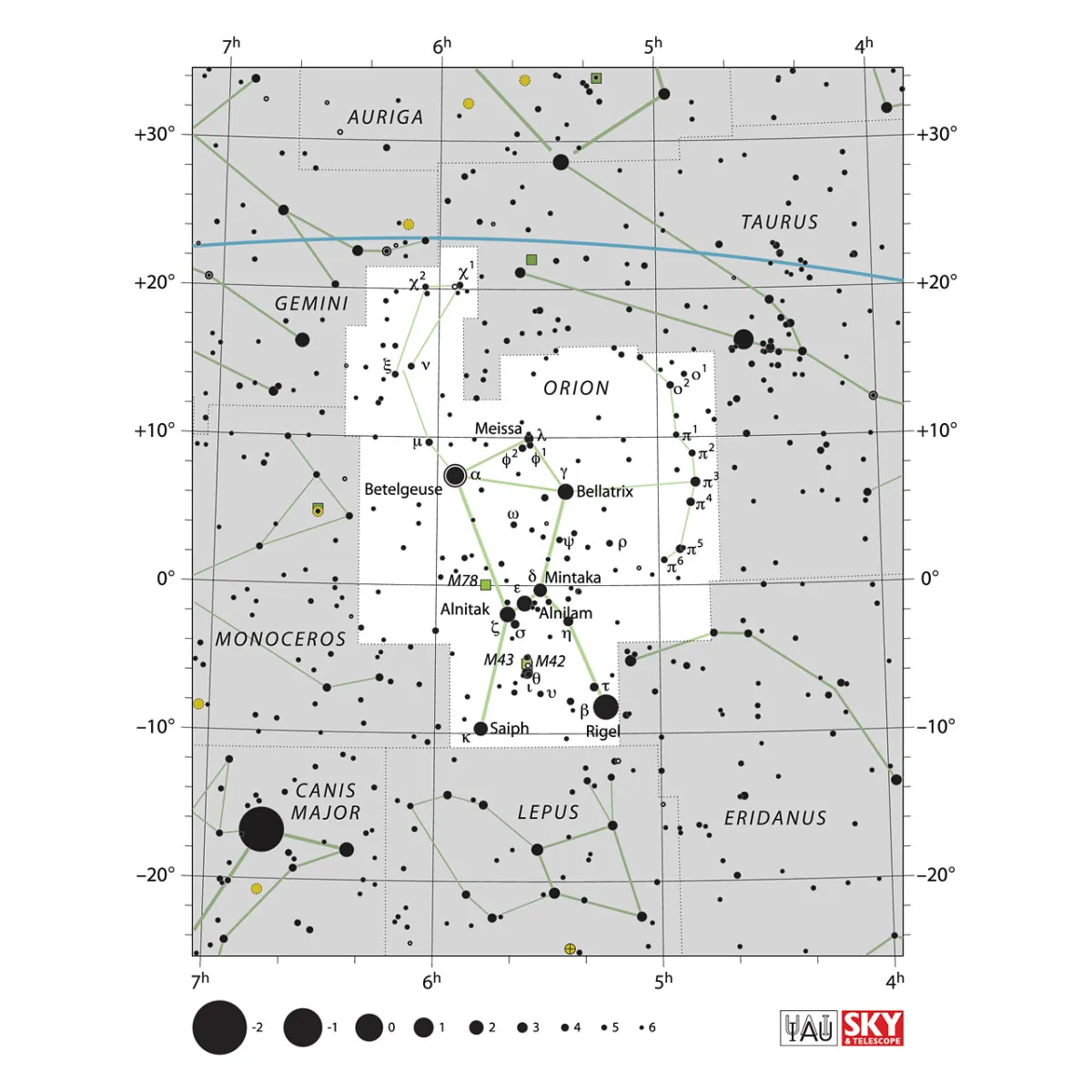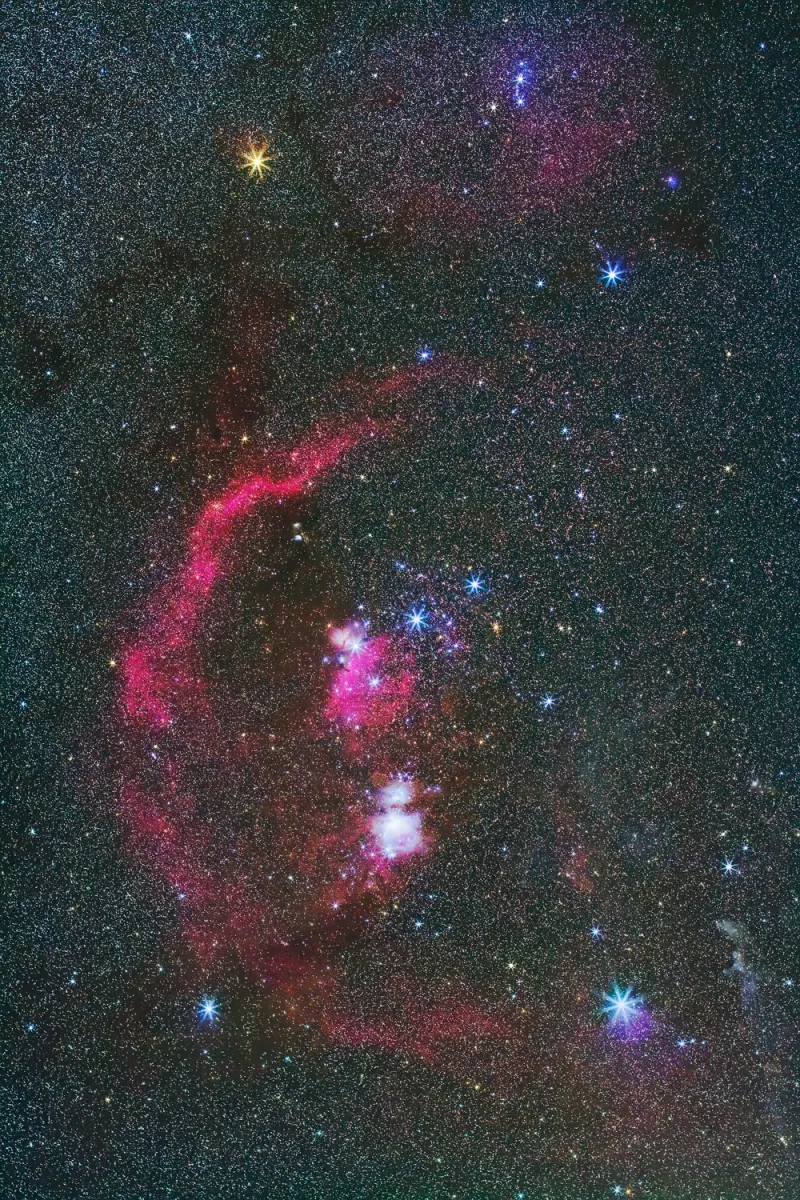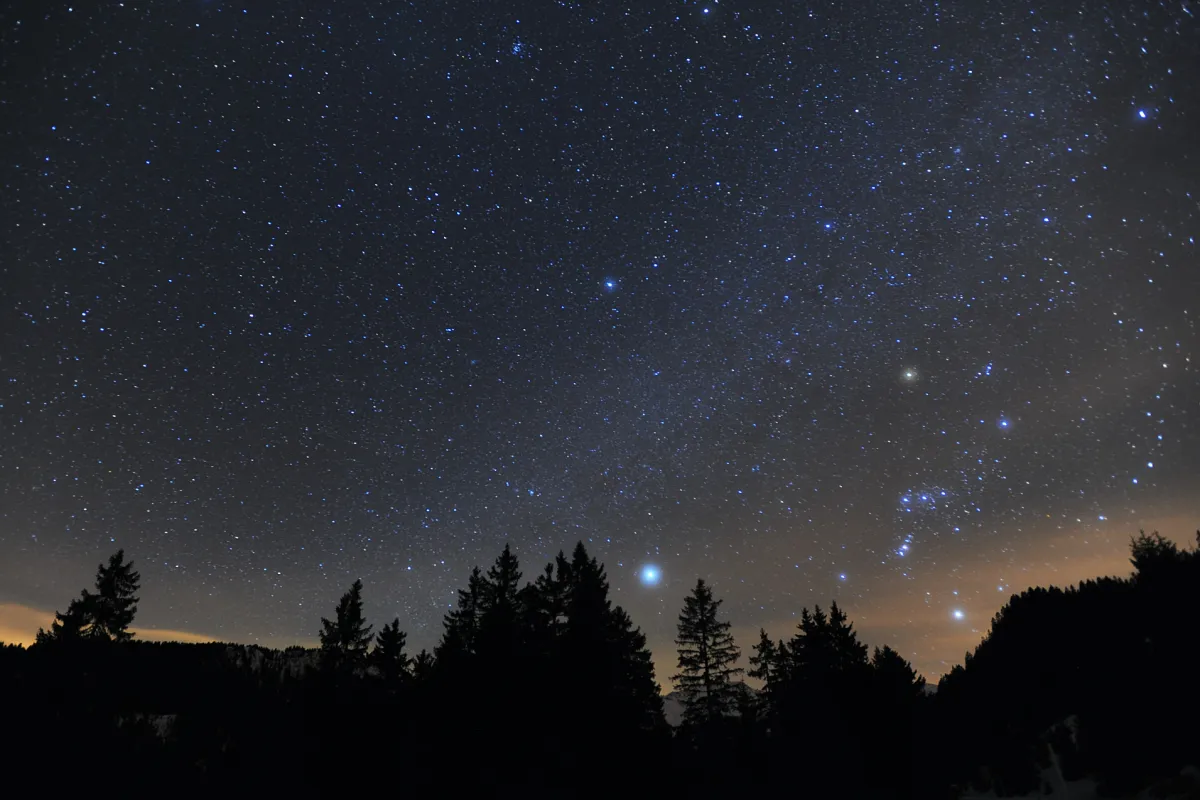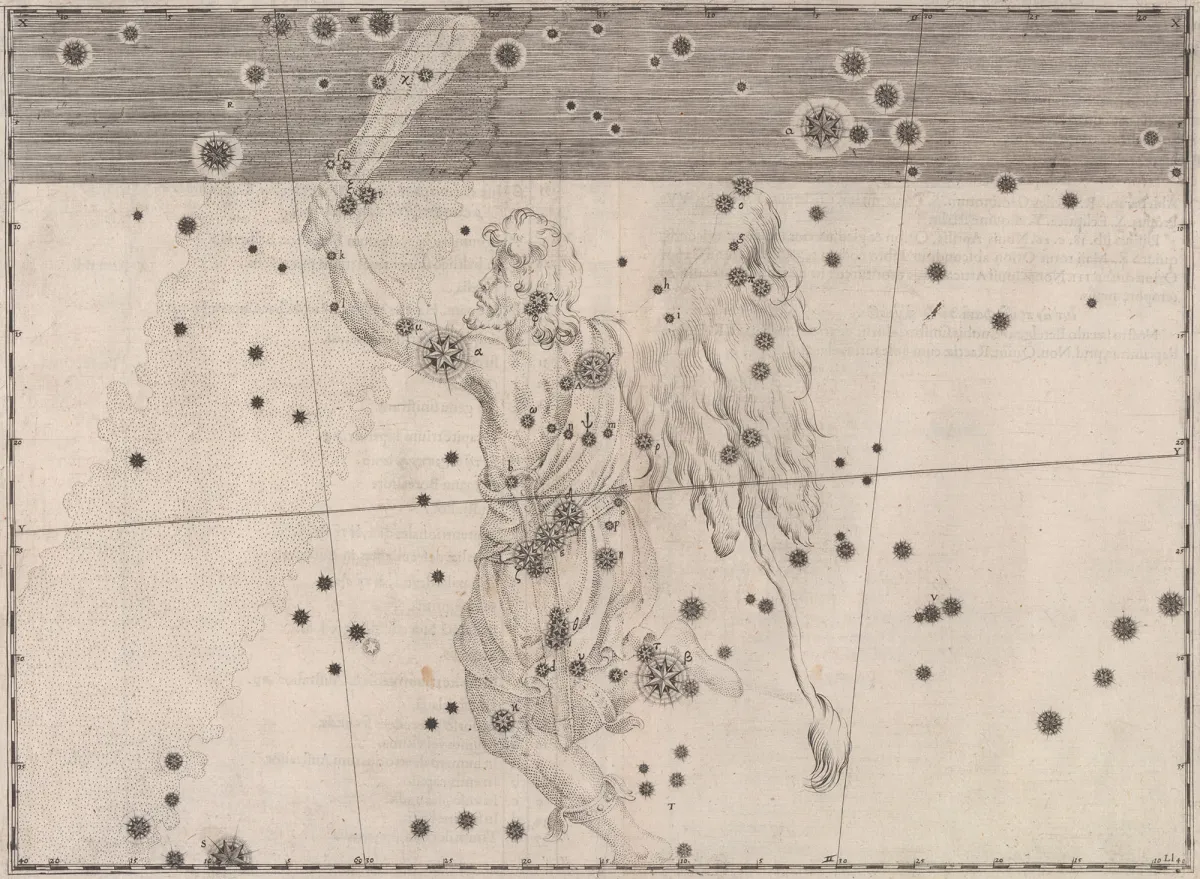Constellation Orion (Hunter)

Properties
The constellation Orion is without a doubt the brightest and perhaps the most famous in the sky. It can be seen in the sky especially in winter. To the northeast is the constellation Gemini, to the northwest Taurus, to the southwest Eridanus, south Lepus and east Monoceros.
By far the most striking feature are the three bright belt stars Alnitak, Alnilam and Mintaka, which lie in a row. But the two shoulder stars Betelgeuse and Bellatrix, as well as the foot stars Saiph and Rigel are not to be despised. Together with the belt stars they form two striking trapezoids. North of the two trapezoids is a small triangle made up of three stars, which represents the head of Orion. A row of weaker stars and the Orion Nebula, which is clearly visible to the naked eye, form the sword of Orion in the southern trapezoid. The constellation therefore reflects the ideal warrior: a large body with a small head. Orion covers an area of 594 square degrees in the firmament and culminates around midnight on December 13th. [9, 15]
Orion is the spectacle of a star formation area with the Orion Nebula, about 1350 light years away, as the central, brightest part of the Orion molecular cloud complex, which extends over the entire constellation spreads out and composed of luminous, reflective as well as dark clouds.
| α Ori | Betelgeuse, Betelguex, Betelgeuze, Beteiguex, Al Mankib |
| β Ori | Rigel, Algebar, Elgebar |
| γ Ori | Bellatrix, The Amazon Star |
| δ Ori | Mintaka, Mintika |
| ε Ori | Alnilam, Alnihan, Alnitam |
| ζ Ori | Alnitak, Alnitah |
| ι Ori | Nair Al Saif, Hatysa |
| κ Ori | Saiph |
| λ Ori | Meissa, Heka |
| υ Ori | Thabit, Tabit |
| IAU Name | Orion |
| IAU Genitive | Orionis |
| IAU Abbr. | Ori |
| English Name | Hunter |
| Culmination at local midnight | 16 December |
| Season (Latitude +0.0°) | August … May |
| Right Ascension (J2000.0) | 04h 43m 25s … 06h 25m 47s |
| Declination (J2000.0) | -10° 58' 43" … +22° 52' 35" |
| Area | 594 deg2 |
| Neighbours (N↻) | Gem, Tau, Eri, Lep, Mon |
Deep-Sky Object Descriptions
Barnard 33
Messier 42
NGC 1999
NGC 2023
NGC 2024
NGC 2169
NGC 2175
Sh 2-261
Sh 2-276
Nebula
Sh 2-279
Catalogues

Mythology and History
Orion is a legendary figure from the most ancient times. He was seen as a role model for a great hunter who won the love of goddesses because of his beauty, but who also persecuted women himself and stalked them without ever reaching them. Orion was the son of Zeus, one third of Poseidon and one third of Hermes. He is also called the «earth-born». But first the story of its origin:
Zeus, the king of the gods, and Poseidon, the god of the seas, and Hermes, the messenger of the gods, went on their way together one evening and passed the little hut of old Hyreius. This was a poor man and had little land to cultivate. He stood in front of his hut and invited them to spend the night. He did not yet recognize the divinity of the three, because they hid them from him.
The three gods entered the old man's house, which was blackened with dark smoke. Little embers glowed on the hearth. Hyreius knelt, made a new fire, and brought two pots of beans and cabbage to a boil. With a shaky hand, he offered his guests red wine. Poseiden was the first to receive the cup, emptied it and said: «Let Zeus drink next.» The old man turned pale when he heard the name, but he composed himself. Then he slaughtered his only bull, which he needed to plow his barren field, and roasted it over a mighty fire. He took out another wine, which he kept in a smoke-blackened jug and which he had once bottled when he was young. The three gods sat down without hesitation on the low deposit, which consisted only of river reeds covered with a linen cloth.

The table soon glowed with the meat and wine that was served. The mixing jug was a red earthen vessel, the cups were made of beech wood. Zeus was touched by the sacrifice of old Hyreius and said: «If you ask for something, wish it! You will receive everything.» The peaceful old man told of his beloved, recently deceased wife and his dearest wish to become a father.
Zeus, Poseidon and Hermes agreed and they all stepped on the peeled, fresh skin of the bull. They emptied their bladder on it and then covered the damp skin by throwing earth on it. It took ten months for it to become a child. Hyreius called it Urion because it was so conceived. The boy grew up very quickly and became handsome and strong. Over time, however, the first letter of his name lost its old sound and from then on it was called Orion. [20]
Orion once hunted a wild beast in the kingdom of Chios, the ruler of which had a beautiful daughter. Orion asked if he could marry her, but the king did not want such a fearsome son-in-law. He tricked Orion by first making him drunk and then blind. Orion, deprived of his eyesight, followed the sound of the hammering hammer of the blacksmith god Hephaestus. The farrier gave the hunter his assistant, a limping cyclops named Cedalion. Orion carried Cedalion on his shoulders, and Cedalion lent Orion his powerful eyesight. He finally helped him to find a country in the "east of the east". There the rising sun healed Orion's eyes. [65]
In its beauty and mightiness, Orion even knew how to captivate goddesses. Delia chose him as a companion, he was the goddess' protector and her follower. According to Homer's report, there was the goddess of the dawn, Eos (Latin Aurora), who, in her constant infatuation, knew how to win Orion. But the daughters of Atlas, the bearer of the heavens, were also connected to him. They were the Pleiades whom Orion loved but never reached. To this day he hurries through the sky night after night without ever catching up with her. Even the virgin goddess of the hunt, Artemis (also moon goddess) was blinded by Orion and finally killed him with arrows out of jealousy and resentment. In retrospect, you can hear another, somewhat weaker version, according to which Orion had to die because he killed too many animals - after all, the goddess of the hunt is also the protector of all wild animals. [20]

According to another version of death, the relationship between Orion and Artemis aroused the jealousy of their twin brother, the sun god Apollo. One day Apollo and Artemis were standing on a beach and he asked them to meet a dark object far away on the sea. That object was Orion's head, visible over the waves as it walked to the bottom of the ocean. Artemis' arrow killed Orion. To comfort you, Zeus granted the hunter a place under the stars. [65]
Another death version is told in which the Scorpio occurs. Hera, the jealous wife of Zeus, sent the scorpion to kill Orion. Even today, Orion is only in the sky when Scorpio has already set. [20, 65]
The Orion was known as a giant, hunter and warrior. The Roman poet Catullus transcribed the Greek name into the word Oarion. According to Ovid's story, Urion is also used, as well as the names Deanae Comes and Amasius, which allude to Orion being the companion and lover of Diana was.
In the Egyptian culture, the much-noticed constellation is close to the gods Horus and Osiris. According to Egyptian myths, Osiris was murdered, dismembered and scattered by his brother Seth, a seedy, ancient Egyptian god. Isis, Osiris' sister, was looking for the dead brother, and, as it were, picked it up and resuscitated it. She then received her son Horus from him, who later assumed the inheritance of Osiris. Osiris was judge and ruler in the realm of the dead and, as the god of vegetation, let plants sprout from the earth and flourish.
From the Jewish tradition comes an identification with Nimrod, an Old Testament figure who was seen as a great hunter. The founding of Babylonia and Assyria is said to go back to him. The image of the hunter for Orion also exists in Roman culture, he was called Venator.
Indians from central Brazil see the Orion as a large rack on which cassava is dried. Cassava is a root plant from which starch is obtained, which is the most important food. Sirius was also included in this picture. [20, 56]